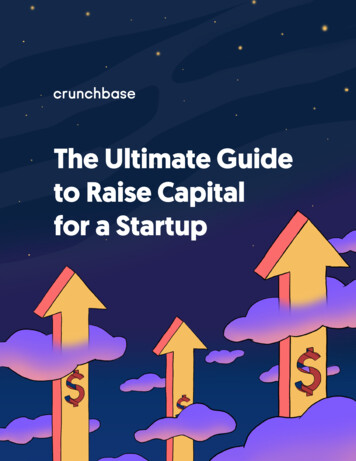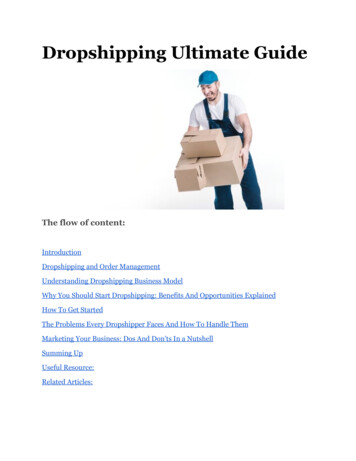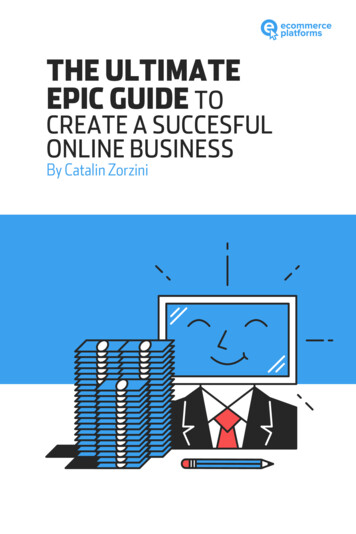
Transcription
The Ultimate Guideto Raise Capitalfor a Startup1
At a GlanceThe Basics: Investor and Funding TypesHow to Choose the Right Investor for Your StartupHow to Find InvestorsInsider Tips When Preparing to Talk to InvestorsHow to Nail Your Pitch and Pitch DeckHow Crunchbase Pro Can Help2
How to RaiseStartup Capital:An OverviewIf you don’t want to raise capital, don’t become a CEO. Raising capital is a CEO’s mostimportant and time-consuming job. Delivering a compelling and organic pitch needsnot only practice, but finesse. We understand that pitching can place entrepreneursin a vulnerable position – after all, what is more personal than your passion?We break down the basics based on the pros’ advice. Here’s a rundown on how tofind, cultivate, and build the most important partnerships in your business.3
The Basics:The Different Startup Funding RoundsVenture Stage Series ASeries BSeries BSeries CLate StageGrowthSeries C LeverageBuyoutPrivate EquityRound
How Venture Capital FundingRounds Differ: The BreakdownAverage Range (USD) 20M 300MTypical Company Valuation 300M 250M 200M 150M 100M 120M 100M 50M 1MTypeInvestortype 1M 3M 150K 1.5M 3M 6M 1M 15M 10M 15M 5M 35M 30M 60MPre-seedSeedSeries ASeries BSeries C Same asseed investors Angels VCs VCs Late-stage VCs Early-stage VCs Super angels Late-stage VCs Private equity firms Friends and family Early-stage angels Accelerators Hedge funds Banks Startup acceleratorsTypicalCompanyStageRaiseTypicallySpent onPre-product Signs of productmarket fit Revenue growth Some traction Marketing becomesincreasinglyimportant Hiring criticalteam members Fuels growingbeyond funding New sales andmarketing processes Developing prototypeproducts Funds productdevelopment Understanding idealcustomer Ability to scale Large-scaleoperations Expensive hires Moving intonew markets Expands into differentmarket segments Fuel acquisitions Experiment withdifferent revenuestreamsSource: From Pre-Seed to Series C: StartupFunding Rounds Explained (Ryan Law)
How to Choosethe Right Investorfor Your StartupBased on Fadl Al Tarzi’s piece, published with permission in Mission.org.Entrepreneurs have a variety of options when it comes to securing funding for anew project.In many ways, this is a good thing. The catch, though, is that each funding optionis drastically different from the next, bearing its own cadre of advantages anddisadvantages. Moreover, deciding which funding route makes the most sense foryou and your startup will vary depending on your circumstances—what your shortterm and long-term goals are, how much money you need, etc. And if you choosethe wrong route, it can condemn your venture before it really even has a chance toget off the ground.That’s why it pays to differentiate between these disparate strategies and theirvarious components with scientific care.That process starts with educating yourself around the characteristics of eachlane. What follows is a primer to get you headed in the right direction based on thethree most common options.6
3 Most Common Types of Investors for StartupsAngel InvestorsTypically a high net worth individual that invests in anew or small business, providing capital in exchangefor equity in the company.Venture Capital InvestorsFirms that are part of the private sector and have apool of money to draw from corporations, foundations, pension funds, and organizations.Family OfficesPrivate wealth management advisory firms thatserve ultra-high-net-worth investors usually exceeding 100 million to manage their investable assets.7
Anatomy of an Angel InvestorAdvantages Shorter closing time More simple due diligence Don’t usually interfere with day-to-day Less aggressive in the terms they demandDisadvantages Their investment amount is smaller than institutional investors Dependent on personal network Won’t prepare you for raising money institutionallyWho Should Choose This Route? Those trying to raise small amount of capital quickly and with few strings attached People with a large personal network Those that don’t want to bring in board members Those that don’t need help setting up governance structures8
Anatomy of a VCAdvantages Can provide significant resources for you in experience and wisdom Will help identify and reach targeted exit Can help correct mistakes which may preclude you from positioningyourself for an exitDisadvantages Aggressive in terms they set Sometimes supposed value-add may not be transferable to yourindustry or companyWho Should Choose This Route? Near-term exit is primary goal Want to leverage industry knowledge - good VCs usually possesshard-won wisdom and business acumen Need bigger investments than angel investors10
Anatomy of a Family OfficeAdvantages Hybrid between VC and angel investor Offer more cash than angel investors but not as much as institutional firms More mission-driven and focused on specific industriesDisadvantages Won’t prepare you for large institutional round Don’t offer much value beyond cash and industry-specific networking Relatively unstructured in their process and approach Fidelity you can expect can differ widelyWho Should Choose This Route? Those looking for the flexibility and casualness of angel investors but wanta bigger sum of cash12
How to FindInvestorsYou probably don’t have the option to pitch your startup to a panel of investors ona national stage. After all, that’s an approach only open to a relatively small number of entrepreneurs. Fortunately, there’s another resource to find investors at yourdisposal — technology.Here are six technologies to help you find investors who are ready to supportyour startup.1. Gust2. Crunchbase Pro3. LinkedIn4. Pitch Investors Live App5. Microventures6. WeFunder14
How Crunchbase CanHelp You Find InvestorsWith Crunchbase Pro you can find investors who invest in companies like yours.Add filters to further narrow down your search. Filter by investor type (angel investor, early stage, late stage VCs etc.) who have invested in a certain sector and roundsize.Registered users can add up to two filters for free, while Crunchbase Pro subscriberscan add as many as they’d like! Here are some example searches:European Investors Who Invest In Seed RoundsNordic Investors Who Invest in US & Asia CompaniesEuropean Investors That Have 5 Exits and Investments in GamingFinancial Services Startups with 1-5 Investors and Angel or Series A15
Insider Tips WhenPreparing to Talkto Investors1. Plan to contact a lot of investors2. Build relationships starting yesterday3. Don’t burn bridges4. Build passion into your pitch5. Follow up three times6. Decide between metrics focus or big-vision7. Pre-qualify your investor8. Don’t run your business like raising money is your MO9. Practice your pitches with “junk” investors10. Draft a pitch deck right after raising a round“The venture capital business is 100% a gameof outliers — it’s extreme competition.Marc Andreessen16
1Plan to Contact at Least 100 InvestorsYou’ll end up only having serious conversations with five, ifthat. Also, make sure this list is targeted and they invest in yoursector. If you’re a biotech company, maybe a SaaS-focusedinvestor isn’t the best bet.Relationship Building Is Crucial –Start Early2If you’re looking to build a company with venture funding, youwill be a fundraiser for at least the next five years of your life.A natural introvert? A great way to keep investors engagedis to add them to a newsletter of quarterly updates. Shootingover a thoughtful and quick news mention or a cool new featurerelease is an excellent way to remind investors you exist.It’s crucial to keep relationships going, even when you aren’tlooking to raise money quite yet, or are too nascent for theinvestor’s target stage.17
3The Venture Community Is Small,Don’t Burn BridgesThis one is pretty self-explanatory. The venture community isshockingly small. Any burned bridges may eventually come backto bite you, particularly when you are looking to raise funds. Ourbest advice? Don’t burn bridges – you never know when a pastrelationship will come back to haunt you.Build Passion Into Your Pitch EverydayThe hardest job you will have as a CEO is keeping the passion alive,4and as hard as it may be, it is your responsibility to bring thatpassion every time you pitch. This is more than just for investormeetings, but for when you pitch candidates and employees.Passion keeps engagement and retention high and keeps employeesfrom checking out. Similarly, investors want to know that buildingyour company is your passion, and exactly what you want to do forthe rest of your life.18
Follow Up Three TimesAbsolutely follow up three times with an investor. No, you will5not be scaring them away. Now, don’t do it over a two-day span, butover a two- to three-week period. Follow up quickly and consistently.With fundraising as your highest priority, ensure you have a coupleof partners to help you manage the communication. Fundraisingis a big and vital project and should be treated as such. Enlist yourEA or COO to help send out collateral. 15% of your dedicatedpartner’s time is spent managing how many times you’ve followedup, who has your deck, and the like.Decide Between Selling MetricsVs. Selling a Big VisionYour goal when pitching is not to have people join your religion, butto convince them that your business is one worth investing in, and6will make your investors money.Depending on your business and the stage of your business youmay need to decide whether it’s better to pitch the hype or yourstrong metrics. Strong metrics that are eating the competition meanthat you may not need to sell the dream because real metrics say thebusiness is working.However, putting yourself against competition can be tricky, particularly if they are large companies. Investors will be disengaged if youpose yourself as a scrappy team of 5 or 6 taking on a company of 300.19
Prequalify Your InvestorPitching to investors shouldn’t feel like a monologue of 20 factslisted by order of importance. Be sure to make pitching a dialogue,7which entails prequalifying an investor.“It’s shocking how few people askwhat is my investment criteria.Courtney Broadus,Spider Capital Partners, Broadway AngelsPrequalify investors to maximize everyone’s time.Quickly establish the investor’s investment criteria. Before goinginto your full pitch, find out if an investor can provide the minimumcapital you’re looking for and if they invest in your sector.Don’t Run Your Business Like RaisingMoney Is the Main Objective8While your main goal as CEO is to fundraise, you need to becareful not to run your business as such. That means not tellingyour employees that you need this particular story to be toldwhen raising capital, whether it be a Series A or B or otherwise.No employee wants to be working at a company that’s alwaysrunning to raise the next round.20
Practice Your Pitches9Lastly, identify your top 10 to 20 investors who investin companies like you, are top-tier, or are competitors ofcompetitor investors. Then put this list aside.When raising capital you want to practice your pitch with “junkinvestors,” and wait until your pitch feels organic. Junk investorsaren’t necessarily bad investors, but they are the investorsyou’re okay not getting your pitch perfect with or not winning.Strategically select when and who to talk to, because you won’tget a second chance to pitch right.Draft a Pitch Deck Right After Raisinga Round10Run your business like your story is your main objective.Crunchbase CEO Jager McConnell explains how right after heraises a round of funding, he will draft a pitch deck for the nextround. Referring back to the pitch deck is a great way to seewhen you are gravitating away from your story, and to ensureyou are always revising and adjusting your story accordingly.21
Now Nail Your Pitch.Now that we’ve reviewed how to talk to investors, we will walk through what toinclude (and not include) in your startup pitch deck. Follow the 30-20-10 rule.30 seconds to state your objective.20 minutes to finish your presentation.10 slides to tell your story.22
What Should BeOn Your Pitch Deck?According to VCs and Successful NextViewVenturesCrowdfunderAirbnbPitch Deck11101115 1213Executive SummaryProblemSolution / Value PropositionMarket Validation / Why Now?ProductMarket SizeBusiness ModelUnderlying MagicCompetitionCompetitive AdvantageMarketing Plan / Go-to MarketFounding TeamBoard / AdvisorsTraction / MilestonesPress / User TestimonialsFundraisingFinancial / Use of FundsSource: Slidebean
What To Definitely IncludeWhen Building Your Pitch DeckBeyond making sure your slide count is less than 15, make sure you include thefollowing slides in your investor pitch deck: Problem Solution/Value Proposition Business Model Competition Founding Team FundraisingDive further into the dos and don’ts of your pitch deck here.24
Raise Startup Capital FasterWith Crunchbase ProResearch investors and competitors in one place withCrunchbase Pro.Crunchbase Pro is a research tool that makes it easyto discover investors and monitor industry trends.From uncovering impressive investors to trackingtargeted acquisitions, stay connected while gettingback to the things that matter.Jump into and edit our sample searches to startfinding your next investor:Find investors: U.S.-based angel investors whoinvest in late-stage roundsBenchmark your raise: Average e-commerce SeriesA startup funding round size in the last six monthsIdentify acquirers: Mobile companies that wereacquired by artificial intelligence companies25
Hedge funds Banks Large-scale operations Moving into new markets Fuel acquisitions Series C 20M - 300M 100M - 120M VCs Super angels Revenue growth Marketing becomes increasingly important New sales and marketing processes Understanding ideal customer Series A 1M 15M 10M 15M Angels Early-stage VCs Accelerators Signs of product .











